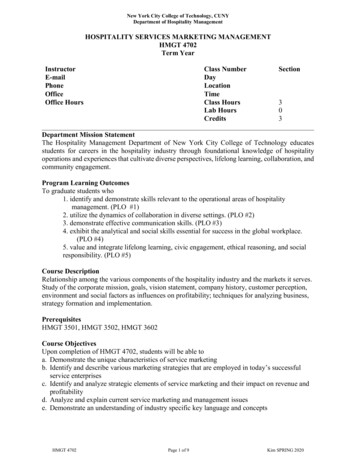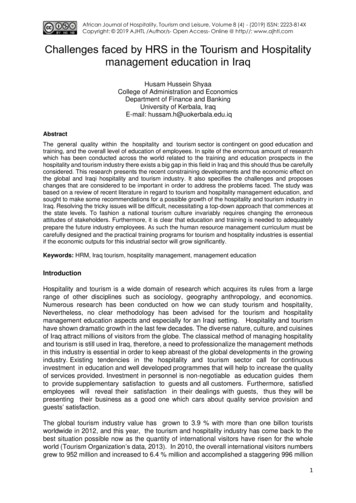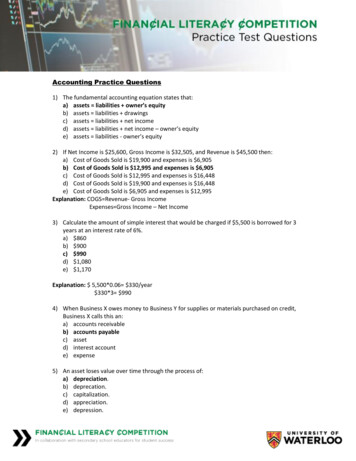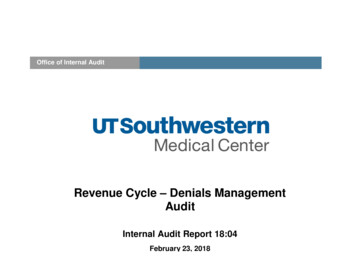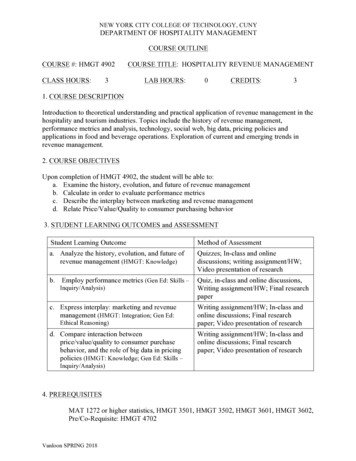
Transcription
NEW YORK CITY COLLEGE OF TECHNOLOGY, CUNYDEPARTMENT OF HOSPITALITY MANAGEMENTCOURSE OUTLINECOURSE #: HMGT 4902CLASS HOURS:3COURSE TITLE: HOSPITALITY REVENUE MANAGEMENTLAB HOURS:0CREDITS:31. COURSE DESCRIPTIONIntroduction to theoretical understanding and practical application of revenue management in thehospitality and tourism industries. Topics include the history of revenue management,performance metrics and analysis, technology, social web, big data, pricing policies andapplications in food and beverage operations. Exploration of current and emerging trends inrevenue management.2. COURSE OBJECTIVESUpon completion of HMGT 4902, the student will be able to:a. Examine the history, evolution, and future of revenue managementb. Calculate in order to evaluate performance metricsc. Describe the interplay between marketing and revenue managementd. Relate Price/Value/Quality to consumer purchasing behavior3. STUDENT LEARNING OUTCOMES and ASSESSMENTStudent Learning OutcomeMethod of Assessmenta. Analyze the history, evolution, and future ofrevenue management (HMGT: Knowledge)Quizzes; In-class and onlinediscussions; writing assignment/HW;Video presentation of researchb.Quiz, in-class and online discussions,Writing assignment/HW; Final researchpaperEmploy performance metrics (Gen Ed: Skills –Inquiry/Analysis)c. Express interplay: marketing and revenuemanagement (HMGT: Integration; Gen Ed:Ethical Reasoning)d. Compare interaction betweenprice/value/quality to consumer purchasebehavior, and the role of big data in pricingpolicies (HMGT: Knowledge; Gen Ed: Skills –Writing assignment/HW; In-class andonline discussions; Final researchpaper; Video presentation of researchWriting assignment/HW; In-class andonline discussions; Final researchpaper; Video presentation of researchInquiry/Analysis)4. PREREQUISITESMAT 1272 or higher statistics, HMGT 3501, HMGT 3502, HMGT 3601, HMGT 3602,Pre/Co-Requisite: HMGT 4702Vanloon SPRING 2018
5. RECOMMENDED TEXTMauri, A. (2012). Hotel revenue management: Principles and practices. Italy: PearsonItalia, Milano—Torino.Select readings from books, journals, and periodicals made available via Blackboard oron reserve in the library6. GRADING SYSTEMWriting Assignments/HW—Posted to BlackboardOnline Discussion—Blackboard ForumIn-class DiscussionQuizzesFinal Research Project *Video Presentation of Research—Posted to BlackboardTotal10%20%10%20%30%10%100%* Final Research Project includes an exploration and analysis of current industry issuesVanloon SPRING 2018
7. ASSIGNMENTPerformance Metrics1) Which statement is true regarding RevPAR?a) It is almost always higher than ADRb) It can be thought of as a combination of Supply and Demandc) When a hotel or GM is evaluated, the RevPAR metric is rarely consideredd) It can be thought of as a combination of Occupancy and ADR(STR Inc., Slide 176)Use the spreadsheet to answer question 2ABCDEFG1Supply Demand Revenue Occupancy ADR RevPAR2 January 2015 465028833747903 February 2015 420023943040384 March 2015465032554622105 March YTD2) The March YTD Occupancy (E5) is(STR Inc., Slide 176)Use the spreadsheet to answer question 3ABCADROccupancy This1This YearYearJanuary2 201563.7120.40February3 201566.3133.744 March 2015 68.5142.655 April 2015 68.2138.00DOccupancyLast 135.92FGOccupancy %ChangeADR %Change3) The Average Daily Rate percentage change for April (G5) is(STR Inc., Slide 177)4) Last month Carl's hotel ran a 55% occupancy. His comp. set had 50,000 room nightsavailable for sale and sold 25,000 rooms. What was Carl's occupancy index last month?(Hayes &Miller, 2011, Question 10, Ch9)5) Last month Carl's hotel had an ADR index of 80.0% and an occupancy index of 120%. Whatwas Carl's RevPAR index for last month?(Hayes &Miller, 2011, Question 15, Ch9)Source of QuestionsQuestion 1, 2, and 3STR Inc. (2017). Hotel industry foundation and introduction to analytics [PowerPoint slides].Retrieved from an authorized Dropbox folder (Slide number 176 and 177)Questions 4 and 5Hayes, D. K., & Miller, A. (2011). Chapter 9: Evaluation of revenue management efforts inlodging—Test Bank. In Revenue management for the hospitality industry Hoboken,New Jersey: John Wiley & Sons, Inc.Vanloon SPRING 2018
8. RUBRICAt Expected LevelProficientCategory6Unattained54321Not accomplished0TaskAccomplishmentIn an excep tional mannerIn a proficient mannerIn a competentmannerIn an adequatemanerAttempted the taskbut did notaccomplish withinexpected rangeProblem SolvingSuperior SkillsSkills used effectivelySatisfactory skillsNearly satisfactoryskillsSkills not usually inevidenceSkills not usuallyevidenced0No serious flaws and fewminor errors which arecounterbalan ced by overalleffectivness of performanceA few seriouserrors and someminor errorsSome serious flawsand minor errorsSeriously flawedExtremely weak inevery aspect0ConceptualKnowledgeKnowledge ofunderlying concept isvery limitednt0kAppropriateStrategiesFrequently innovative,selected and rigorouslyemployedSelected and employedFrequentlyemployedUsed inconsistentlyInappropriatelyselected or appliedUnable to select orapply0TheoreticalKnowledgeApp lied consistently to theproblemApplied to the problemApp lied moreoften than not tothe problemT enuously app liedto the problemVery Limited and isusually not connectedto the problemLacking0ComputationsComputations necessary tcomplete task are accuratAlmost all Computationsnecessary to complete thetask are accurateMost computationsare incorrect ormissing0Communicationand Di rectionsDirections followed in anexemplary fash ion andresponses communicatedclearly and effectivelyDirection s followed andresponses communicatedeffectivelyMostcomputationsnecessary tocomp lete the taskare accurateDirectionsfollowed andrespon sescommunicatedreasonab ly wellSome computationsErrors or omissions innecessary t ocom putations arecomp lete the taskfrequentare accurateAttempts to followdirections and tocommunicate clearlyare not alwayssuccessfu lFails to followdirections and mayhave difficulty inattempting tocom municateres onsesDirections notfollowed, responsedare notcommunicated in aneven mimimallysatisfactor fashionIv our Total ScoreII!Maximum Score IIlvour GradeVanloon SPRING 2018IIol48 10% 1
WEEKLY COURSE OUTLINECOURSE: HMGT 4902COURSE TITLE:HOSPITALITY REVENUEMANAGEMENTWEEK 1History of Revenue Management Aim, evolution and futureWEEK 2Organization of Lodging Industry Chain, parent company, management company, owner or asset managementcompanyWEEK 3Geographic Market and Non-Geographic Market Categorizations Geographico World, continent, sub-continent, country, market, submarketo Non-Geographico Scale and classWEEK 4Benchmarking levels Property, corporate and tourism organizationsCompetitive SetsDevelopment and use of primary and secondary competitive setsWEEK 5Performance Metrics—objectives and outcomes Raw data Key performance indicators Percent change Multiple time periods Index calculation and usesWEEK 6STR Global Industry Reports Property levelo Ad-hoco Trend reporto Profitability/HOST Reporto Pipeline ReportStar Global Destination Report Customizable region, market and select set QuizWEEK 7Interplay Between Marketing and Revenue Management Concept of Service Characteristics of Service Relationship marketing—value creation Fluctuations in Services Demand Operations Cost StructureVanloon SPRING 2018
WEEK 8Price Concept of pricePricing methodologiesDynamic pricingStrategic and tactical pricing policyConsumer surplus—willingness to pay and segmentationDifferential pricing—lodgingWEEK 9Value and Quality Seller’s perspective of value Buyer’s perception of value Dimensions of Quality Quality/Value/Price interaction—lodging products Perception of fairness—best available rate, rate parity, rate integrity QuizWEEK 10Hotel Distribution Channels Non-electronic/traditional distribution channels Electronic distribution channels (i.e., online travel agents, OTA’s)Revenue management softwareWEEK 11Business Processes of Revenue Management in Lodging Mapping the revenue management process Segmentation and segment buying characteristics Forecasting demand Inventory allocation/optimization methods Overbooking and service recovery Revenue manager’s role in business processWEEK 12Revenue Management—Food and Beverage Operations Food and beverage pricing methods Differential pricing—food and beverage Quality/Value/Price interaction—food and beverage Analysis of revenue sourceso Menu mix evaluation—food and beverage Type of food and beverage operationo Traditional dine-in and alternative formats Calculation and evaluation of revenue per available seat hour (RevPASH) QuizVanloon SPRING 2018
WEEK 13Implications of changing consumer behavior on revenue management Big data and Big analytics Emergence of social webWEEK 14Site visit to include conversations with a hotel’s Director of Revenue Management andDirector of MarketingWEEK 15Current and emerging trends driving revenue management as discussed in the scholarlyand professional/trade sources.Vanloon SPRING 2018
WEEKLY COURSE OBJECTIVESCOURSE: HMGT 4902COURSE TITLE:HOSPTALITY REVENUEMANAGEMENTThe student will be able to . . .WEEK 1Examine the primary aim of revenue management, discuss the evolution and future of revenuemanagement from a tactical approach to a strategic management approach of inventory.WEEK 2Explain the organization of lodging industry in terms of chain, parent company, managementcompany, owner or asset management companyWEEK 3Categorize and define hotels based on geographic market and non-geographic marketWEEK 4Define benchmarking, discuss its strategic and analytical applications, describe the variousbenchmarking levels, create and apply primary and secondary competitive setsWEEK 5Measure and evaluate, raw data used in calculating hotel performance metrics, calculate andevaluate key performance indicators, percent change, multiple time periods, and various indexesWEEK 6Analyze STR Global industry property level and destination reportsWEEK 7Assess the major forces driving the convergence of Marketing and Revenue ManagementWEEK 8Examine and compare, the concept of price and pricing policies, identify internal and externalfactors influencing pricing decisions, and the influence of pricing policies at strategic and tacticallevelWEEK 9Explain the link between value, quality, price from the perspective of the buyer and seller.Discuss the concept perceived price fairness.WEEK 10Compare electronic and non-electronic distribution channels for lodging products. Identifyfundamental attributes of various revenue management software solutionsVanloon SPRING 2018
WEEK 11Articulate/map the business processes of revenue management in lodging industry and describethe revenue manager’s role.WEEK 12Express the framework of revenue management as implemented in food and beverage operationsWEEK 13Analyze, big data, explain big data analytics and social web’s influence on revenue managementWEEK 14Analyze the roles of and importance of interaction between a hotel’s Director of RevenueManagement and Director of Marketing via site visit observationsWEEK 15Identify and evaluate the current and emerging trends driving revenue management as discussedin scholarly and professional/trade sources.Vanloon SPRING 2018
SELECTED BIBLIOGRAPYBodea, T., & Ferguson, M. (2014). Segmentation, revenue management, and pricing analytics.New York: Routledge: Taylor & Francis.Hayes, D. K. (2011). Revenue management for the hospitality industry. Hoboken, New Jersey:John Wiley & Sons, Inc.Haynes, N., & Egan, D. (2017). Revisiting the relevance of economic theory to hotel revenuemanagement education and practice in the era of big data. Research in HospitalityManagement, 7(1), 65-73.Jiang, L. (2014). Revenue management in a multi-channel environment: The effect of pricingstrategies on perceived fairness. (Doctor of Philosophy), University of Nevada, LasVegas,Josephi, S. H. G., Stierand, M. B., & van Mourik, A. (2016). Hotel revenue management: Then,now and tomorrow. Journal of Revenue and Pricing Management, 15(3-4), 252-257.Kaminski, J., & Smith, B. (2016). An HVS guide to hotel revenue management. Retrieved fromhttps://tinyurl.com/y9sbf5elKimes, S. E. (1994). Perceived fairness of yield management. Cornell Hotel and RestaurantQuarterly, 35(1), 62-72.Kimes, S. E. (2016). The evolution of hotel revenue management. Journal of Revenue andPricing Management, 15(247-251).Kimes, S. E., & Chase, R. B. (1998). The strategic levers of yield management. Retrieved fromhttps://tinyurl.com/y8dtxcmjLegohérel, P., Poutier, E., & Fyal, A. (Eds.). (2013). Revenue management for hospitality &tourism. Woodeaton, Oxford: Goodfellow Publishers Limited.Liozu, S. M. (2016). The evolution and future pricing capabilities. Journal of Revenue andPricing Management, 15(3-4), 306-316.Martins, M., & Monroe, K. B. (1994). Perceived price fairness: A new look at an old construct.Advances in Consumer Research, 21, 75-78. Retrieved from https://tinyurl.com/y9j89yxpMasiero, L., & Law, R. (2015). Comparing reservations channels for hotel rooms: A behavioralperspective. Journal of Travel & Tourism Marketing, 33(1), 1-13.Mauri, A. (2012). Hotel revenue management: Principles and practices. Italy: Person Italia,Milano—Torino.Vanloon SPRING 2018
McGill, J. I., & Van Ryzin, G. J. (1999). Revenue management: Research overview andprospects. Transportation Science, 33(2), 233-256.McGuire, K. A. (2016). Hotel pricing in a social world: Driving value in the digital economy.Hoboken, NJ: John Wiley & Sons, Inc.Ng, I. C. L. (2010). The future pricing and revenue models. Journal of Revenue and PricingManagement, 9(3), 276-281.Noone, B. M., Enz, C. A., & Glassmire, J. (2017). Total revenue management: A strategic profitperspective. Cornell Hospitality Report, 17(8).Rose, P. (2016). A lifetime in airline revenue management. Journal of Revenue and PricingManagement, 15(3-4), 197-202.STR Global Glossary: A guide to our terminology. (2018). Retrieved January 2018, from STRGlobal https://tinyurl.com/y9m2ouwgTalluri, K. T., & Van Ryzin, G. J. (2005). The theory and practice of revenue management. NewYork, NY: Springer Science Business Media, Inc.Tranter, K. A., Stuart-Hill, T., & Parker, J. (2009). An introduction to revenue management:Principles and practices for the real world (1st ed.). Upper Saddle River, New Jersey:Person Education, Inc.van Meerendonk, P. (2016). The evolution of revenue management and big data. Hotel BusinessReview. Retrieved from https://tinyurl.com/ycrx5jdrVinod, B. (2016). Evolution of yield management. Journal of Revenue and Pricing Management,15(3-4), 203-2011.Webb, T. (2016). From travel agents to OTAs: How the evolution of consumer booking behaviorhas affected revenue management. Journal of Revenue and Pricing Management, 15(3-4),276-282.Yeoman, S., & McMahon-Beattie, U. (2017). The turning points of revenue management: Abrief history of future evolution. Journal of Tourism Futures, 3(1), 66-72. n SPRING 2018
revenue management. 2. COURSE OBJECTIVES Upon completion of HMGT 4902, the student will be able to: a. Examine the history, evolution, and future of revenue management b. Calculate in order to evaluate performance metrics c. Describe the interplay between marketing and revenue management d. Relate Price/Value/Quality to consumer purchasing .
